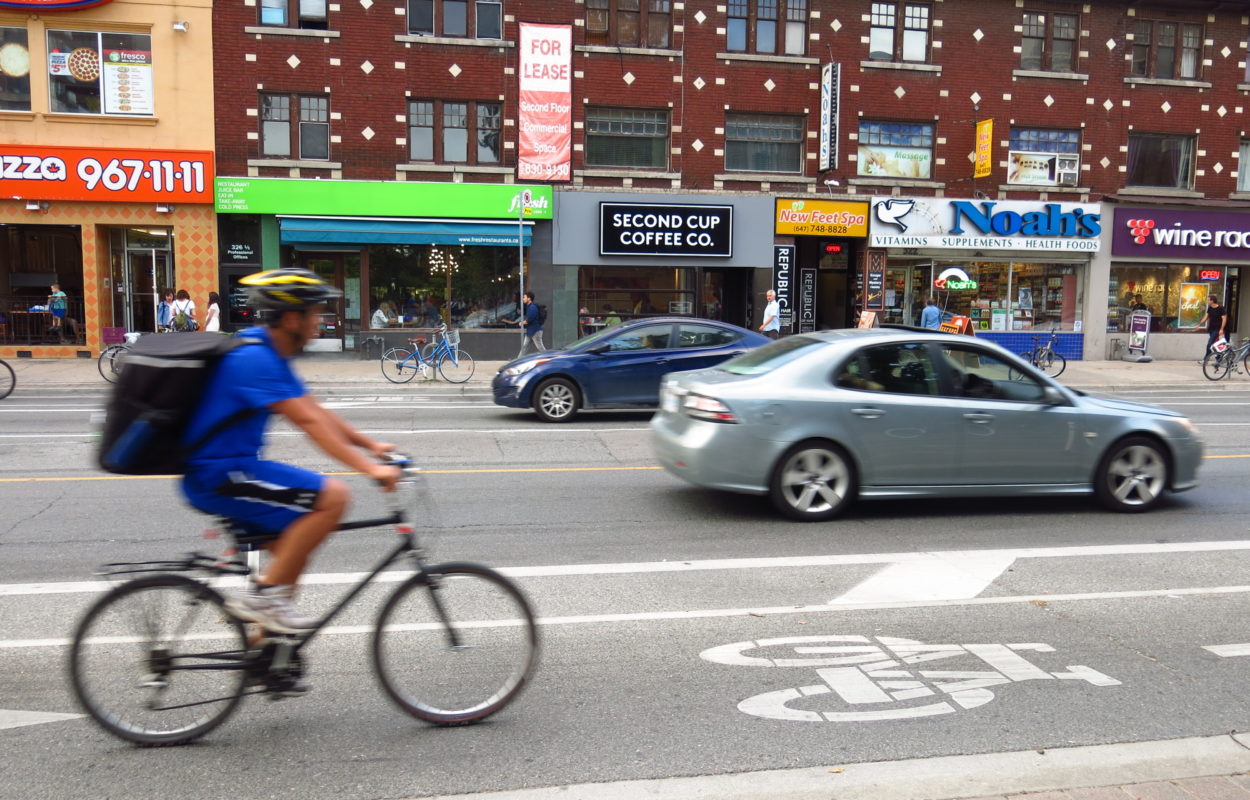
Photo Credit: Yvonne Verlinden
In October, TCAT’s study on the economic impact of the pilot bike lanes on Bloor Street will be part of the evaluation considered by the Public Works and Infrastructure Committee when it makes a recommendation regarding the future of the bike lanes. This long-awaited report has been led by TCAT with specialized expert assistance on study design, data collection and data analysis provided by academic researchers from the University of Toronto. At three different times, a wealth of information was collected, totaling 525 surveys with merchants, 3,005 surveys with visitors, 15 bicycle counts and 2 business vacancy scans. The study design was agreed upon with the first three project partners, the Korea Town BIA, the Bloor Annex BIA, and the Metcalf Foundation, in 2015, before data collection began and before the installation of the bike lane. The study design incorporates the following elements to ensure the most reliable and objective information possible:
- A Control Site
Changes along a commercial street can happen for many reasons (such as shifts in neighbourhood demographics, increasing property taxes, and the rise of e-commerce). Data was collected along Danforth Avenue, a comparable shopping street with no bike lane, to determine whether changes on Bloor Street were due to the bike lane or to other factors common to both streets. - Before and After Data
The opinions people currently hold can influence the way they remember the past, especially over a long period of time. For this reason, the study collected data both before and after the bike lane’s installation. Asking people about their current spending habits, travel choices, or visiting frequency in 2015, and again in 2016 and 2017, and then comparing those responses is more reliable than asking them to recall what their behaviour was a year ago and to say whether there was any change. In order to make responses consistent and comparable, the same questions were used for all three time periods. - Non-Leading Questions
The survey was designed to avoid people’s responses being influenced by their support or disapproval of the bike lane. Specifically, the survey script did not mention the bike lanes, but instead introduced itself as “a survey regarding local business and how people get here”. Questions which mentioned the bike lane were not asked until after the core economic data (customer counts, visit frequency and spending) had been gathered. - Random and Representative Samples
The study was designed to capture the full spectrum of possible responses, and not only those of a specific subset. For visitor surveys, every third person walking along the sidewalk was approached and asked if they would like to participate in the survey. For the merchant surveys, every street-level business was approached. If the owner or manager were unavailable, up to three repeat visits were made and contact information was left for them to follow up. - Third Party Data Collection and Analysis
Being surveyed by someone who is familiar to you and whose views you know can influence the responses you give. TCAT, as a non-profit with a public mandate to advance knowledge and evidence related to active transportation, partnered with researchers from the University of Toronto to ensure impartial data collection and analysis. - Multiple Data Sources
Recently, interest is growing in using economic data from third party payment platforms, such as Visa, Moneris or Apple Pay, which, while not comprehensive, may provide an indication of sales trends. In the summer of 2017, the City of Toronto began talking with Moneris to obtain point-of-sale data. However, in 2015, at the start of this study, such data was unavailable to the research team. The alternative of collecting sales data from merchants was considered by the research team and the BIAs, but collectively it was decided that it would be too difficult to ensure that the majority of businesses would participate and the BIAs expressed reluctance to ask their members to open their books, due to privacy concerns. The funding partners and the research team agreed that a survey question regarding sales without data to verify it would be insufficient. Since then, the Ontario Association of BIAs has also recommended against collecting retail sales data through surveys to merchants because of transparency and uniformity issues. This study instead looks at multiple data sources to estimate economic impact, an approach that has been used by other jurisdictions, including the City of Calgary in evaluating its pilot bike lanes. The indicators are: estimated customer counts from the merchant surveys, estimated spending and visit frequency from the visitor surveys, and business vacancy counts from a street level scan.
Want more info about the study and can’t wait for the report to be released? Read our FAQ.
